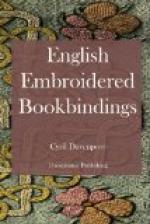The back is divided into four panels, in which are, alternately, a rose-tree on which are two red roses with yellow centres and green leaves, growing from a grass plot, and a blue rose with yellow centre and green leaves under a red cloud with silver rays. There are several spangles and some small pieces of coloured purl scattered about in the spaces.
The book is in excellent condition, owing, no doubt, to the fact that most of it is in metal, but it is representative of the lowest level to which the art of the embroidered book in England has ever fallen.
Psalms. London, 1639.
A charming little piece of delicate workmanship occurs in a copy of the Psalms, printed in London in 1639, and bound in white satin. It measures 3 by 2 inches. The design on each side is the same, but the work is slightly different. A tall rose-tree, with gold stem, grows from a small chenille base, the rose petals beautifully worked in the finest of stitches, as well as the leaves, all of which are outlined with fine gold thread. From the lower branches of the rose-tree hang on one side a violet, and on the other a pansy, each worked in the same way as the rose, and edged with fine gold thread. The back is divided into four panels, containing respectively a cornflower, a pomegranate, a fruit, perhaps meant for an apple, and a honeysuckle, all conventionally treated and very delicately worked. The edge is bound all round with a strong braid, and there is one tie of broad, cherry-silk ribbon. With this book is its canvas bag, embroidered in silver ground with coloured-silk flowers and tassels of silver, the general design and workmanship of which nearly resembles that of the finer bag already described at page 16. The silver has turned nearly black, as is usually the case with these bags.
[Illustration: 45—Psalms. London, 1639.]
[Illustration: 46—The Way to True Happiness. London, 1639.]
The Way to True Happiness. London, 1639.




